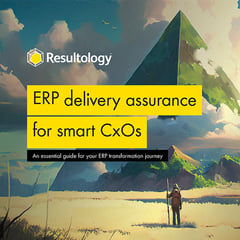One advantage of being part of the “old guard” is that sometimes you get to give a wry smile and nod sagely when something “new” comes along - yes, you’ve been there before - the technology industry is not immune to cycles.
I started my SAP career back in 1996 working on SAP R/2 for one of the biggest companies in the UK at the time, Imperial Chemical Industries (ICI). I was a systems programmer and part of the team that would be called Technology Consultants today.
R/3 had been out for about 4 years and ICI was in the process of transitioning to the new client-server technology and expanding its SAP footprint.
ICI had bought into the concept that it was a good thing to integrate much of its core business processes in SAP R/3 and move away from disparate point solutions.
R/3 wasn’t the best finance solution in the world… but it was integrated with the rest of SAP.
R/3 wasn’t the best logistics system in the world… but it was integrated with the rest of SAP.
You get the message, and many others did which resulted in SAP R/3 / ECC becoming one of the most, if not the most, successful enterprise software applications ever.
But things are changing.
ICI as an entity is long gone and SAP has grown both organically and by acquisition, buying independent software vendors to develop it’s portfolio.
For example - did you know that SAP sells a software telephony switch? Not many people do. In some cases, SAP had three or four products that performed essentially the same functions, many of which overlapped with the mighty SAP Business Suite.
Then along came The Cloud.
Competition from agile SaaS vendors such as Salesforce, Workday, and Microsoft Dynamics started to encroach on SAP’s market share and its age-old nemesis - Oracle - became a cloud-only vendor. SAPs fully-integrated on-premise Business Suite started to look a bit old hat.
So SAP’s response was two-fold - firstly to actively promote the new functionality of its cloud-based acquisitions such as Ariba, SuccessFactors, Fieldglass etc instead of the equivalent in SAP Business Suite - effectively deprecating previously core functionality.
Secondly it announced S/4HANA to the world and the concept of shrinking the digital core. The concept was that S/4HANA would deliver the truly core business functionality (finance, purchasing, logistics etc) using standard processes, while other processes such as sourcing and HR would be delivered by the new acquisitions. The functionality that delivered competitive advantage could be delivered by the multitude of enablers and solutions under the umbrellas of SAP Cloud Platform, SAP Leonardo etc.
So the wheel has turned a full 180 degrees.
We’ve gone from a single solution replacing lots of point solutions from different vendors, to a single solution being split into lots of point solutions.
But, the difference here is that the point solutions are all from the same vendor.
So what’s the problem ?
When everything was together in SAP Business Suite it was difficult for competitors to encroach as there was always the argument “we’ve paid for the licenses and the functionality is already in ECC/CRM/APO/SCM/BW - we can just tweak it if we need to”.
Now, with SAP re-focussing development into a wider range of separately licensed solutions, there is no longer the imperative to keep everything in one place.
And, as data lakes with the required analytics on top become more commonplace, organisations will still have access to consolidated data.
This, together with the perceived effort to migrate to S/4HANA means that now there is a legitimate conversation that “if we’ve got to buy more licenses and the effort to move to SAP’s post 2025 vision is significant, we might as well look at alternatives.”
On the other side of the coin, there are a couple of factors to consider :
Integration - Gartner has estimated that integration will take up to 50% of the time and cost to build a digital solution.
Obviously, organisations will want to minimise this and SAPs key advantage here is that it is able to deliver out-of-the-box integration between its own products far more rapidly and efficiently than for competitors.
New Technology - IoT, machine intelligence, smart analytics and how businesses adopt it.
To give SAP its due - it does come up with some cool technology but the key to adoption is real-life use cases, and SAP is very good at illustrating these to CxOs.
If SAP can persuade the right people that its technology can enable game-changing improvements then they can head off the competitors early.
So is SAP 0-1 down at half time?
Not yet, but SAPs strategy has effectively opened up its own user base to competition.
Only time will tell what effect new technology and customer loyalty will have on business IT decisions.
If you need help understanding how to choose products contact us here.












